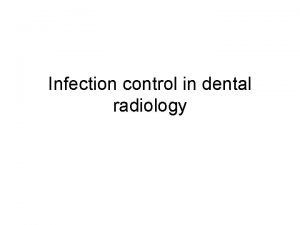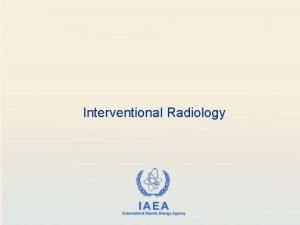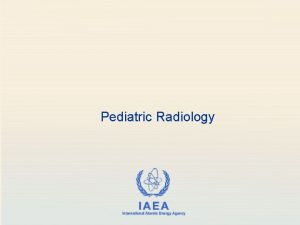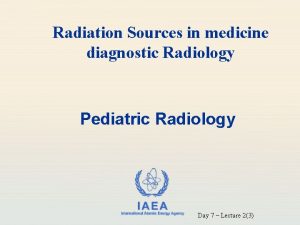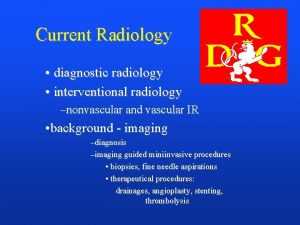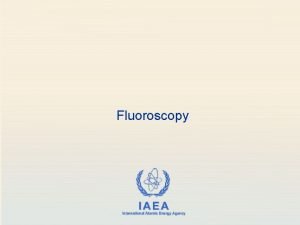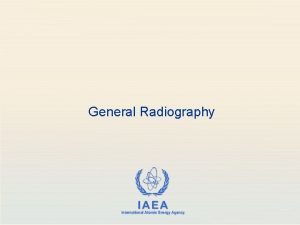Dental Radiology Authorization and Inspection of Radiation Sources
















- Slides: 16

Dental Radiology

Authorization and Inspection of Radiation Sources in Diagnostic and Interventional Radiology Module 2. 9 Objective • To become familiar with dental x-ray systems. • To become familiar with specific radiation risks associated with this equipment. 2

Authorization and Inspection of Radiation Sources in Diagnostic and Interventional Radiology Contents Module 2. 9 • Description and characteristics of equipment for intra-oral radiography. • Description and characteristics of equipment for panoramic radiography. • Description and characteristics of equipment for cephalometric radiography and cone beam computed tomography (CBCT). • Equipment malfunction affecting radiation protection. • Minimum requirements for routine maintenance. 3

Authorization and Inspection of Radiation Sources in Diagnostic and Interventional Radiology Module 2. 9 Dental X-ray Equipment • Dental radiography is one of the most common x-ray examinations in the industrialized world. • Although individual radiation doses and risks are low, many extensive examinations are performed in younger age groups. • As for other radiological procedures, patient doses can be significantly influenced by the equipment and techniques used and the quality assurance measures in place. 4

Authorization and Inspection of Radiation Sources in Diagnostic and Interventional Radiology Module 2. 9 Dental X-ray Equipment (cont) Different types of equipment are used depending on the type of image required. e. g. • x-ray equipment for intra-oral radiography uses small intraoral non-screen x-ray films or digital image receptors for bitewing or periapical radiography; • equipment for panoramic tomographic radiography uses a narrow fan shaped x-ray beam (~5 -10 mm wide and 150 mm high) which rotates around different axes within the patient’s head to provide a defined image of the plane of the dental arch. Other unwanted structures are deliberately blurred during this process. 5

Authorization and Inspection of Radiation Sources in Diagnostic and Interventional Radiology Module 2. 9 Dental X-ray Equipment (cont) Intraoral x-ray examination FILM HOLDER AND POSITIONING DEVICE 6

Authorization and Inspection of Radiation Sources in Diagnostic and Interventional Radiology Module 2. 9 Specific Requirements for Intraoral Equipment • The operating tube voltage should be at least 60 k. V peak. • The filtration in the useful beam should be equivalent to at least 1. 5 mm Al at x-ray tube voltages up to 70 k. V peak and 2. 5 mm if greater than 70 k. V peak. • X-ray tube focus to skin distances of 200 mm or greater are recommended. • The diameter of the x-ray beam should not be greater than 60 mm at the outer end of the beam applicator. • Rectangular collimation is recommended. 7

Authorization and Inspection of Radiation Sources in Diagnostic and Interventional Radiology Module 2. 9 Specific Requirements for Intraoral Equipment (cont) • The fastest films consistent with the required clinical results should be used. • Whenever practicable, film holders incorporating beam aiming devices should be used. • On new equipment, manufacturers should provide a range of x-ray outputs and exposure times so that different speed image receptors (faster film and digital image receptors) can be correctly exposed. 8

Authorization and Inspection of Radiation Sources in Diagnostic and Interventional Radiology Module 2. 9 Dental X-ray Equipment (cont) Older “pointer cone” equipment. Open ended collimation (right) should be used 9

Authorization and Inspection of Radiation Sources in Diagnostic and Interventional Radiology Module 2. 9 Specific Requirements for Panoramic Equipment • The rotation of the x-ray tube around the head that provides the tomographic image of the entire dental arch must be precise and reproducible. • Patient positioning devices should be simple, reliable and accurate. • A fast intensifying screen / film combination (or comparable speed image receptors) should be used. • All new equipment should incorporate a range of radiographic exposures consistent with clinical requirements, the patient’s build (i. e. adults, children) and the speed of the image receptor. 10

Authorization and Inspection of Radiation Sources in Diagnostic and Interventional Radiology Module 2. 9 Dental X-ray Equipment (cont) Panoramic tomographic x-ray equipment 11

Authorization and Inspection of Radiation Sources in Diagnostic and Interventional Radiology Module 2. 9 Dental X-ray Equipment (cont) Panoramic tomographic x-ray equipment patient positioning devices 12

Authorization and Inspection of Radiation Sources in Diagnostic and Interventional Radiology Module 2. 9 Dental X-ray Equipment (cont) For orthodontic analysis (the diagnosis and treatment of dental disorders), two techniques are routinely employed: • cephalometry, which provides reproducible images of the skull, dentition and facial profile including the soft tissue; • CT examinations (dedicated dental Cone Beam CT (CBCT) scanner). 13

Authorization and Inspection of Radiation Sources in Diagnostic and Interventional Radiology Module 2. 9 Specific Requirements for CBCT • Equipment should provide choice of volume sizes (Field of View - FOV) to allow for proper collimation for a given examination • Equipment should provide choice of voxel sizes (Resolution) appropriate for different examination types • Equipment should incorporate a range of selectable loading factors (tube voltage, tube current, “low dose” setting) consistent with clinical requirements such as patient size 14

Authorization and Inspection of Radiation Sources in Diagnostic and Interventional Radiology Module 2. 9 Image development Number Improper x-ray film development is a significant cause of unnecessary patient exposure and reduced film quality. Bitewing exposures Sample size 651 Mean dose (m. Gy) 3. 14 This survey of bitewing doses indicates problems with film development. Doses should range from 2. 5 to 3. 0 m. Gy (without back scatter). m. Gy (air kerma at skin entrance surface) Radiological Council, Western Australia 2000 Annual Report 15

Authorization and Inspection of Radiation Sources in Diagnostic and Interventional Radiology Module 2. 9 Malfunctions affecting radiation protection Basically the same as for general x-ray system (see modules 2. 1, 2. 2 and 2. 3) but the tests performed and the measuring instruments used shall be adapted to the particular characteristics of the dental system under investigation: e. g. • inaccuracy and inconsistency of the x-ray tube voltage and radiation output; • inaccurate or defective timer; • misalignment between the x-ray beam and the image receptor; • unsatisfactory film storage conditions, image development and viewing conditions. 16
 Authorization
Authorization Pa dental radiology ce requirements
Pa dental radiology ce requirements Radiographic errors in dentistry ppt
Radiographic errors in dentistry ppt Darkroom infection control guidelines
Darkroom infection control guidelines Print sources of information
Print sources of information Sújb
Sújb Ionizing radiation sources
Ionizing radiation sources Nuclear energy facts
Nuclear energy facts Imp of water resources
Imp of water resources Asp.net mvc 5 identity authentication and authorization
Asp.net mvc 5 identity authentication and authorization Ohsu health services
Ohsu health services Authentication authorization auditing
Authentication authorization auditing Grid security infrastructure
Grid security infrastructure Pharmacology and venipuncture
Pharmacology and venipuncture Radiology mergers and acquisitions
Radiology mergers and acquisitions American academy of oral and maxillofacial radiology
American academy of oral and maxillofacial radiology Oral disease
Oral disease



